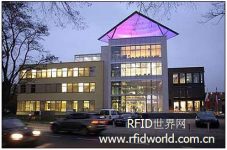
Fraunhofer Institute of MEMS and Systems tests RFID application in InHaus2 smart building project
[ad_1]
The In-Haus Center project established by the Fraunhofer Institute of Micro-Electro-Mechanical and Systems (IMS), after the successful construction of the “inHaus1” intelligent real house in Duisburg, Germany in 1995, the “inHaus2” intelligent building technology project was re-launched in May 2006 . This large-scale project in cooperation with Germany’s oldest and largest construction and construction company HOCHTIEF will combine the expertise of the nine institutes of Fraunhofer and the financial support of the Nordrhein-Westfalen federal government. It is expected to cost 34 million euros and is scheduled for 2010. The actual test of the building can be carried out every year.
InHaus2 is currently one of the most innovative construction sites in Europe.The project is specifically designed for new-style nursing homes, hospitals, office buildings, hotels and other functional buildings (non-residential buildings).Building) Provide a platform for R&D and testing of innovative intelligent building system solutions.

InHaus2 is currently one of the most innovative construction projects in Europe
InHaus2 is adjacent to the inHaus1 project (a platform that provides R&D and testing of many innovative solutions for residential buildings). The key technology applications include: adopting new constructionMaterials such as: self-encrypting concrete; optimizing the construction process through electronic intelligent systems; reducing operating costs; logistics management technology; intelligent chemical safety inspection systems; using lasersScan the panorama of the simulated construction site (compare and adjust with the actual panorama); all materials in the life cycle of the building are digital files; energy-saving technology (environmental structure/buildingTechnology/Design/New Building Materials)
During the construction of the InHaus 2 project, Fraunhofer used RFID to track building materials and monitor the air pressure of the insulation panels.The institute hopes to test how RFID technology isAccurately and easily measure the air pressure of 25 insulation panels. Changes in air pressure will affect the insulation function of the insulation panels.

Install RFID temperature sensor tags on the concrete ceiling of the building
In order to measure and track air pressure, the researchers used Fraunhofer’s patented air interface protocol to design an RFID tag that integrates a pressure sensor.ResearchThe staff also designed an RFID reader for reading the label of the insulation board.This RFID system ensures that the installer of the insulation board completes the work correctly (without damaging the insulation board)). Property management personnel can check whether the insulation board is working properly and whether it needs to be repaired by keeping the label in the board.
In addition, Fraunhofer also installed 133 kHz RFID tags using a patented air protocol on the ceiling of the InHaus building.The label has a temperature sensor embedded in it, researchThe test tag can be used to monitor the temperature in the building.
Two site material tracking test projects
Frederic Meyer, who is in charge of the RFID part of the InHaus 2 project, said that the purpose of using RFID to manage materials on the construction site is to speed up the flow of materials and ensure that working days are not wasted due to material shortages. In addition, Fraunhofer and Hochtief believe that RFID can help manage the security documents required by the government, because RFID can also track building components after the building is completed.
The first RFID project was launched in the spring of 2008. Researchers put EPC Gen 2 tags on 50 metal packaging frames used to fix cement blocks to test the feasibility of using RFID to track the flow of materials on construction sites. Although workers know that metal may interfere with RF signals, the use of such materials is high, and workers often cannot find suitable metal packaging boxes.
During the project, the vehicle loaded with the metal frame passed through a gated entrance on the construction site, and a Feig Electronic RFID reader read the tags. Researchers found that the RF signal is too weak, which affects the reading rate; in addition, due to insufficient reading distance design, some tags cannot be read. In the one-month test, the average read rate was only 30%.

A truck carrying labeled doors and windows passes through an RFID door reader

Labeled doors and windows and loading racks
The second project on the construction site uses RFID to track building doors and windows. When the doors and windows are delivered, important information is manually written on a paper label attached to the doors and windows. However, when doors and windows are cleaned for the first time, paper labels are often lost. Researchers use RFID tags to replace paper tags. The ID number of the tag corresponds to the door and window information in the database. During the test, the researchers put EPC Gen 2 tags on the doors and windows and the loading racks that carry them. After the doors and windows are installed, they are also labeled with passive low-frequency tags (133 kHz).
When the truck with doors and windows passes through the RFID door reader, the reader reads the tag. When the doors and windows are installed on the building, employees can use the handheld to identify each 133 kHz tag. The door and window labeling project has lasted for 5 months, Meyer said, during this period staff can read the label. Similarly, managers can also read tags to track the maintenance history of doors and windows.
[ad_2]



